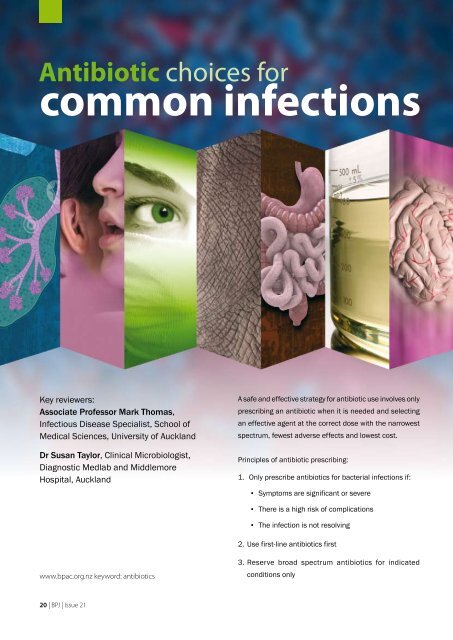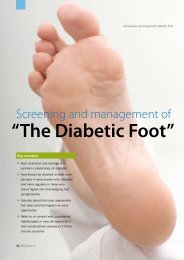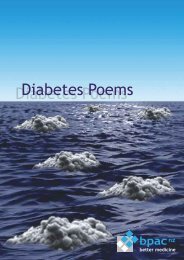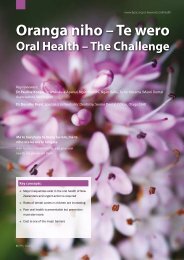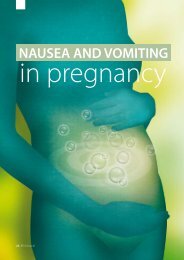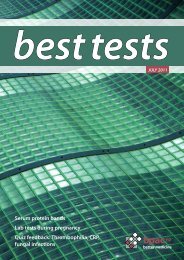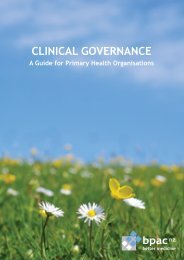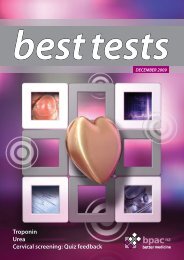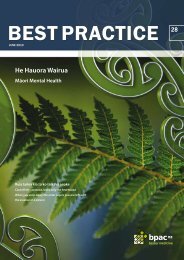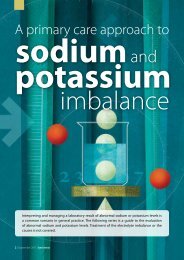common infections - Bpac.org.nz
common infections - Bpac.org.nz
common infections - Bpac.org.nz
Create successful ePaper yourself
Turn your PDF publications into a flip-book with our unique Google optimized e-Paper software.
Antibiotic choices for<br />
<strong>common</strong> <strong>infections</strong><br />
Key reviewers:<br />
Associate Professor Mark Thomas,<br />
Infectious Disease Specialist, School of<br />
Medical Sciences, University of Auckland<br />
Dr Susan Taylor, Clinical Microbiologist,<br />
Diagnostic Medlab and Middlemore<br />
Hospital, Auckland<br />
A safe and effective strategy for antibiotic use involves only<br />
prescribing an antibiotic when it is needed and selecting<br />
an effective agent at the correct dose with the narrowest<br />
spectrum, fewest adverse effects and lowest cost.<br />
Principles of antibiotic prescribing:<br />
1. Only prescribe antibiotics for bacterial <strong>infections</strong> if:<br />
▪▪ Symptoms are significant or severe<br />
▪▪ There is a high risk of complications<br />
▪▪ The infection is not resolving<br />
2. Use first-line antibiotics first<br />
www.bpac.<strong>org</strong>.<strong>nz</strong> keyword: antibiotics<br />
3. Reserve broad spectrum antibiotics for indicated<br />
conditions only<br />
20 | BPJ | Issue 21
The following table is intended as a guide for selecting an appropriate antibiotic for <strong>infections</strong> <strong>common</strong>ly seen in general<br />
practice. Local resistance patterns and individual patient circumstances may alter the choice of antibiotic.<br />
Respiratory<br />
Acute bronchitis<br />
Management<br />
Common pathogens<br />
Antibiotic therapy<br />
Most acute bronchitis is of viral origin and therefore antibiotics are not indicated. Purulent<br />
sputum alone does not indicate the need for antibiotics. Antibiotics may be appropriate<br />
for those with co-morbidity or of advanced age.<br />
Respiratory viruses<br />
Less <strong>common</strong>ly: Bordetella pertussis, Mycoplasma pneumoniae, Chlamydophila<br />
pneumoniae<br />
Not usually indicated<br />
Acute exacerbation of chronic bronchitis<br />
Management Most exacerbations are likely to be viral and antibiotics are of limited benefit.<br />
Patients with severe exacerbations and those with more severe airflow obstruction at<br />
baseline are most likely to benefit from antibiotics.<br />
Common pathogens<br />
Antibiotic therapy<br />
First choice<br />
Alternatives<br />
Respiratory viruses, Streptococcus pneumoniae, Haemophilus influe<strong>nz</strong>ae, Moraxella<br />
catarrhalis<br />
Amoxycillin 500 mg 3 times daily for 5 days<br />
Doxycycline 100 mg 2 times daily for 5 days<br />
Pneumonia – adult<br />
Management<br />
Common pathogens<br />
Antibiotic therapy<br />
First choice<br />
Consider chest x-ray to confirm diagnosis.<br />
The decision to treat with oral antibiotics as an outpatient depends on the age of the<br />
patient, co-morbidities and clinical signs indicating severity (HR > 100 bpm, RR > 24 bpm,<br />
temp. ≥ 38°C, signs of focal consolidation on examination).<br />
Respiratory viruses, S. pneumoniae, H. influe<strong>nz</strong>ae, M. pneumoniae, C. pneumoniae,<br />
Legionella pneumophila, Staphylococcus aureus<br />
Amoxycillin 1 g 3 times daily<br />
Plus either (to cover atypical infection):<br />
Roxithromycin 300 mg daily or Doxycycline 200 mg stat then 100 mg daily<br />
Duration of treatment is approximately 7 days.<br />
Alternatives<br />
Monotherapy with erythromycin, doxycycline or co-trimoxazole are alternatives for those<br />
with a history of penicillin allergy.<br />
N.B. Roxithromycin offers an alternative to erythromycin as they are both macrolide antibiotics.<br />
BPJ | Issue 21 | 21
Pneumonia – child<br />
Management<br />
Common pathogens<br />
Antibiotic therapy<br />
First choice<br />
Alternatives<br />
In a young child, suspect pneumonia if tachycardia, grunting, indrawing and high fever in<br />
absence of wheeze (auscultatory findings un<strong>common</strong>).<br />
The decision whether a patient receives inpatient or outpatient therapy depends on<br />
clinical severity. Patients who have systemic toxicity or any indication of respiratory failure<br />
should be treated in hospital.<br />
Respiratory viruses, S. pneumoniae, H. influe<strong>nz</strong>ae, M. pneumoniae<br />
Amoxycillin 25 mg/kg 3 times daily for 7 days<br />
Erythromycin<br />
If no response in 48 hours, review diagnosis and consider referral to hospital.<br />
Pertussis<br />
Management Community outbreaks of pertussis occur approximately every four years (see page 42).<br />
Notifiable disease.<br />
Antibiotics do not effect the course of the disease if they are given more than seven days<br />
after the illness has started. However, they may be justified during the first four weeks of<br />
the illness to limit transmission to susceptible contacts.<br />
Common pathogens<br />
Antibiotic therapy<br />
First choice<br />
B. pertussis<br />
Erythromycin 10 mg/kg (up to 500 mg) 4 times daily for 14 days<br />
Ear, nose and throat<br />
Otitis externa – acute or “swimmers ear”<br />
Management<br />
Common pathogens<br />
Antibiotic therapy<br />
First choice<br />
Alternatives<br />
Gentle debridement of the ear canal may be necessary to enhance the effectiveness of<br />
topical treatment. Suction cleaning is also a safe and effective method of debridement.<br />
Most topical antibacterials are contraindicated in the presence of a perforated drum or<br />
grommets.<br />
Pseudomonas aeruginosa, S. aureus, polymicrobial <strong>infections</strong><br />
Clioquinol + flumethasone (Locorten Vioform) 2 to 3 drops 2 times daily<br />
or<br />
Dexamethasone + framycetin + gramicidin (Sofradex) 2 to 3 drops, 3 to 4 times daily.<br />
Acetic acid 2% (Vosol) or ciprofloxacin + hydrocortisone (Ciproxin HC)<br />
22 | BPJ | Issue 21
Otitis media – acute<br />
Management Immediate antibiotic therapy is usually unnecessary.<br />
Common pathogens<br />
Antibiotic therapy<br />
Consider antibiotics for those in high risk groups such as children with systemic symptoms,<br />
children under 6 months or children under 2 years with severe or bilateral disease.<br />
Otherwise treat symptomatically (e.g. paracetamol) and arrange follow up or give a<br />
prescription to be dispensed if no improvement in next 24 hours.<br />
Respiratory viruses, S. pneumoniae , H. influe<strong>nz</strong>ae, M. catarrhalis<br />
First choice Amoxycillin 40 mg/kg/day in 2 to 3 divided doses (max. 3 g daily) for 5 days (7 to 10 days if<br />
< 2 years, underlying medical condition, perforated drum, chronic or recurrent <strong>infections</strong>)<br />
Alternatives<br />
Erythromycin, cefaclor or co-trimoxazole<br />
Pharyngitis<br />
Management<br />
Common pathogens<br />
Antibiotic therapy<br />
First choice<br />
Most pharyngitis is of viral origin.<br />
Give antibiotics only if:<br />
▪▪ Features of group A strep infection: temperature >38°C, no cough, tender cervical<br />
nodes, tonsillar swelling or exudates, especially if aged 3–14 years. If uncertain swab<br />
throat.<br />
▪▪ Patient aged 3–45 years and at high risk of rheumatic fever: Māori and Pacific<br />
peoples, lower socioeconomic areas of North Island, past history of acute rheumatic<br />
fever.<br />
▪▪ Existing rheumatic heart disease (treat at any age).<br />
Respiratory viruses, Streptococcus pyogenes<br />
Phenoxymethylpenicillin 500 mg (child 10 mg/kg) twice daily for 10 days<br />
or<br />
Alternatives<br />
stat IM be<strong>nz</strong>athine 0.6 MU if 27 kg<br />
Erythromycin ethylsuccinate<br />
Acute sinusitis<br />
Management Most patients with sinusitis will not have a bacterial infection.<br />
Common pathogens<br />
The following cluster of symptoms may suggest bacterial sinusitis:<br />
▪▪ Purulent nasal discharge persisting more than 7 days<br />
▪▪ Facial pain or maxillary tooth ache<br />
▪▪ Unilateral sinus tenderness<br />
▪▪ Fever<br />
Although studies suggest there may be limited benefit, an antibiotic can be considered if<br />
these symptoms are present.<br />
Respiratory viruses, S. pneumoniae, H. influe<strong>nz</strong>ae, M. catarrhalis, anaerobic bacteria<br />
(reflecting extension of dental abscess)<br />
BPJ | Issue 21 | 23
Acute sinusitis (continued)<br />
Antibiotic therapy<br />
First choice Amoxycillin 500 mg (child 15 mg/kg) three times daily for 7 days<br />
Alternatives Doxycycline, cefaclor or co-trimoxazole<br />
If anaerobes suspected, use amoxycillin/clavulanic acid<br />
Eyes<br />
Conjunctivitis<br />
Management<br />
Allergic, viral or bacterial.<br />
Bacterial more likely if eyelids very sticky or unilateral.<br />
Viral more likely if starts bilaterally.<br />
Most bacterial conjunctivitis (except Chlamydia trachomatis or Neisseria gonorrhoeae) is<br />
self-limiting and two thirds of cases improve in 2 to 5 days.<br />
Common pathogens<br />
Antibiotic therapy<br />
First choice<br />
Alternatives<br />
Assess for keratitis (using fluorescein stain) in contact lens wearers before treating as<br />
conjunctivitis.<br />
Viruses, S. pneumoniae, H. influe<strong>nz</strong>ae, S. aureus<br />
In newborns, consider C. trachomatis or N. gonorrhoeae, in which case topical therapy is<br />
inadequate and referral to a paediatrician is recommended.<br />
Topical chloramphenicol until 48 hours after infection has cleared<br />
Topical fusidic acid or topical framycetin<br />
Skin<br />
Bites and clenched fist* <strong>infections</strong><br />
Management Clean and debride wound thoroughly and treat with antibiotic.<br />
Assess patient’s need for tetanus immunisation.<br />
Consider referral if bone or joint involvement.<br />
Common pathogens Polymicrobial infection , Pasteurella multocida, Capnocytophaga conimorsus (cat and dog<br />
bites), Eikenella corrodens (fist injury), S. aureus, streptococci and anaerobes<br />
Antibiotic therapy<br />
First choice Amoxycillin/clavulanic acid 500/125 mg three times daily for 5 to 10 days<br />
Alternatives Metronidazole plus either doxycycline or co-trimoxazole<br />
* Injury to fist from contact with teeth<br />
24 | BPJ | Issue 21
Boils<br />
Management Most lesions may be treated with incision and drainage alone.<br />
Antibiotics may be considered if fever, surrounding cellulitis or co-morbidity e.g. diabetes<br />
or if the lesion is in a site associated with complications e.g. face.<br />
Common pathogens<br />
Antibiotic therapy<br />
First choice<br />
Alternatives<br />
If recurrent boils (e.g. more than 10 boils over more than 3 months) consider<br />
staphylococcal decolonisation with a one week course of intranasal mupirocin or fusidic<br />
acid.<br />
S. aureus<br />
Flucloxacillin 500mg 4 times daily for 7 to 10 days<br />
Erythromycin, cefaclor, co-trimoxazole<br />
Cellulitis<br />
Management Antibiotic treatment is indicated.<br />
Keep affected area elevated and assess response to treatment. May require referral if<br />
severe.<br />
Common pathogens<br />
Antibiotic therapy<br />
First choice<br />
Alternatives<br />
For periorbital cellulitis, in all but very mild cases consider referral for IV antibiotics.<br />
S. pyogenes, S. aureus, Group C or Group G streptococci<br />
Flucloxacillin 500 mg 4 times daily for 7 to 10 days (the addition of penicillin is not<br />
required)<br />
Erythromycin, cefaclor, co-trimoxazole<br />
Diabetic foot <strong>infections</strong><br />
Management Length of treatment depends on clinical response or whether there is possible<br />
involvement of the bones of the feet. Referral may be required.<br />
Common pathogens Polymicrobial infection i.e. a mixture of anaerobes, Gram-positive and Gram-negative<br />
aerobes<br />
Antibiotic therapy<br />
First choice Amoxycillin/clavulanic acid 500/125 mg three times daily, usually 5 to 10 days<br />
Alternatives Cefaclor or co-trimoxazole plus metronidazole<br />
Impetigo<br />
Management Remove crusted area and apply topical antibiotic treatment. Keep affected areas covered<br />
and stay away from school for 24 hours after treatment initiated (see BPJ 19).<br />
Common pathogens S. aureus, S. pyogenes<br />
Antibiotic therapy<br />
First choice Fusidic acid cream for 7 days<br />
Alternatives Flucloxacillin (oral) for 7 days for extensive lesions or topical treatment failure<br />
BPJ | Issue 21 | 25
Mastitis<br />
Management Treat with antibiotic and continue to breast feed from both breasts. This is an important<br />
component of treatment and poses no risk to the infant (see BPJ 18).<br />
Common pathogens S. aureus, anaerobes in non-lactating women or in men<br />
Antibiotic therapy<br />
First choice Flucloxacillin 500 mg 4 times daily for 7 days<br />
Alternatives Cefaclor, erythromycin<br />
Gastrointestinal<br />
Campylobacter<br />
Management Most people will recover with symptomatic treatment only. Antibiotics have little impact on<br />
the duration and severity of symptoms but eradicate stool carriage.<br />
Antibiotic treatment is indicated if symptoms are severe or prolonged. Treatment<br />
may also be reasonable in food handlers, childcare workers and those caring for<br />
immunocompromised patients.<br />
For pregnant women nearing term, Campylobacter gastroenteritis should be treated with<br />
erythromycin to prevent exposure of the neonate to Campylobacter during vaginal delivery.<br />
Notifiable disease.<br />
Common pathogens<br />
Antibiotic therapy<br />
First choice<br />
Alternatives<br />
Campylobacter jejuni, Campylobacter coli<br />
Erythromycin 250 mg – 500 mg (child 10 mg/kg) three times daily for 5 days<br />
Norfloxacin 400 mg twice daily for 5 days is an alternative although resistance is likely if the<br />
infection was acquired overseas<br />
Clostridium difficile toxin disease<br />
Management Treat with metronidazole and discontinue other antibiotics when possible.<br />
Antidiarrhoeals (e.g. loperamide) should be avoided as the toxin may be retained and<br />
worsen colitis.<br />
Relapse occurs in approximately 20% of people.<br />
Common pathogens<br />
Antibiotic therapy<br />
First choice<br />
Clostridium difficile<br />
Metronidazole 400 mg orally three times daily for 7 to 10 days<br />
Giardiasis<br />
Management Avoid lactose-containing foods for one month after therapy.<br />
Notifiable disease<br />
Common pathogens<br />
Giardia lamblia<br />
26 | BPJ | Issue 21
Antibiotic therapy<br />
First choice<br />
Ornidazole 1.5 g orally once daily for 1 or 2 days<br />
or<br />
Metronidazole 2 g (child 30 mg/kg/day) orally once daily for 3 days<br />
Alternatives<br />
For treatment failure:<br />
▪▪ Exclude re-infection from asymptomatic family contacts e.g. children<br />
▪▪ Use metronidazole 400 mg (child 10 mg/kg) three times daily for 7 days<br />
Salmonellosis<br />
Management Routine treatment with antibiotics is usually unnecessary and may prolong excretion.<br />
Treat in severe disease or immunocompromised patients.<br />
Notifiable disease.<br />
Common pathogens<br />
Antibiotic therapy<br />
First choice<br />
Alternatives<br />
Salmonella enteritidis, Salmonella typhimurium<br />
Norfloxacin 400 mg orally twice daily for 3 to 5 days<br />
Co-trimoxazole (400 + 80 mg tablets) 2 tablets twice daily for 3 to 5 days<br />
Urinary<br />
Cystitis<br />
Management Non-pregnant women with uncomplicated cystitis do not require investigation. Males,<br />
children and pregnant women require urine culture (see Laboratory Investigation of UTI,<br />
June 2006, for more information).<br />
Antibiotic therapy is indicated for all people who are symptomatic. Asymptomatic bacteriuria<br />
requires antibiotic treatment in pregnant women but not in elderly women or patients with<br />
long-term indwelling urinary catheters.<br />
Treat for longer in pregnant women (7 days) and in men (10 to 14 days).<br />
Pregnant women should have repeat urine culture 1 to 2 weeks after completing therapy to<br />
ensure cure.<br />
Common pathogens<br />
Antibiotic therapy<br />
First choice<br />
Alternatives<br />
E. coli, Staphylococcus saprophyticus, Proteus sp., Klebsiella sp., Enterococcus sp.<br />
Trimethoprim 300 mg once daily for 3 days (usually avoided during the 1st trimester).<br />
Nitrofurantoin 50 mg four times daily for 5 days (usually avoided at term), cefaclor 500 mg<br />
three times daily for 3 days or amoxycillin/clavulanic acid 500+125 mg twice daily for 3<br />
days.<br />
Norfloxacin is an alternative but should be reserved for isolates resistant to initial empiric<br />
choices.<br />
BPJ | Issue 21 | 27
Acute pyelonephritis<br />
Management Only treat as an outpatient if mild symptoms e.g. low fever and no nausea or vomiting. If<br />
systemically unwell or vomiting refer for IV treatment.<br />
Common pathogens E. coli, Proteus sp., Klebsiella sp., Enterococcus sp.<br />
Antibiotic therapy<br />
First choice Trimethoprim 300 mg once daily for 10 to 14 days<br />
Alternatives Co-trimoxazole 400+80 mg 2 tablets twice daily for 10 to 14 days or amoxycillin/clavulanic<br />
acid 500+125 mg three times daily for 10 to 14 days or cefaclor 500 mg three times daily<br />
for 10 to 14 days.<br />
CNS<br />
Bacterial meningitis<br />
Management In most cases, give antibiotic before transport to hospital in suspected cases of<br />
meningococcal disease.<br />
If practical, collect blood cultures before antibiotic administration.<br />
Notifiable disease.<br />
Common pathogens<br />
Neisseria meningitides, S. pneumoniae<br />
Less <strong>common</strong>:<br />
Listeria monocytogenes, H. influe<strong>nz</strong>ae<br />
Antibiotic therapy<br />
First choice<br />
Alternatives<br />
Be<strong>nz</strong>ylpenicillin 1.2 g (child – 50 mg/kg) IV or IM<br />
Amoxycillin 1 to 2 g (child – 50 to 100 mg/kg) IV or IM<br />
Ceftriaxone 50 mg/kg up to 2 g IV or IM<br />
References:<br />
1. Everts R. Antibiotic guidelines for primary care, Nelson and Marlborough Districts 2007-2008.<br />
2. Ellis-Pegler R, Thomas M. Approaches to the management of <strong>common</strong> <strong>infections</strong> in general practice. Diagnostic Medlab 2003.<br />
3. Lang S, Morris A, Taylor S, Arroll B. Management of <strong>common</strong> <strong>infections</strong> in general practice: Part 1. NZ Fam Phys 2004;31(3):176-8.<br />
4. Lang S, Morris A, Taylor S, Arroll B. Management of <strong>common</strong> <strong>infections</strong> in general practice: Part 2. NZ Fam Phys 2004;31(4):258-60.<br />
5. Australian Medicines Handbook. Adelaide Australian Medicines Handbook Pty Ltd, 2006.<br />
6. British National Formulary 56 ed. London: British Medical Association and the Royal Pharmaceutical Society of Great Britain, 2008.<br />
7. Lang S, editor. Guide to Pathogens and Antibiotic Treatment. 7th ed, 2004. Available from: http://dml.co.<strong>nz</strong>/ (Accessed April 2009).<br />
28 | BPJ | Issue 21


